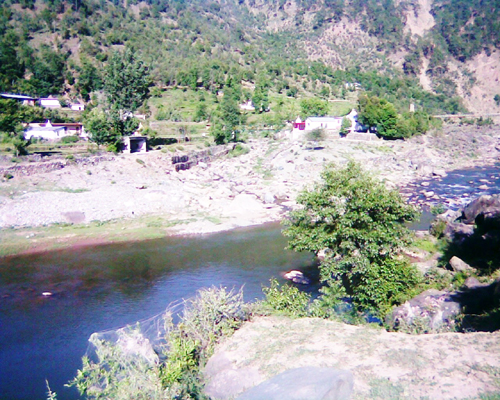Ayodhya Nath Kerni
Rivers have a great role in the development of society. They do play a pivot role in the history of civilization. We talk of Ganga-Yamuna rivers and civilization as well. Tawi is not as big as Ganga or Chenab but certainly a life line of Jammu region. There was acute shortage of water in the region before inflow of Tawi river. According to legends and folk belief it is assumed that initially Tawi river was flowing in another direction. Tawi orginates from the lap of a ridge called as Sirojari (Kali Kund) in Sioj Dhar falling under Tehsil Ramnagar. Gujjars call it as Nakke. Niru starts flowing from Kailash Kund in Bhaderwah and Ujh originates from Sawan Kund. The entire region was ruled by the Nagas prior to the period it came under the pale of Aryanisation.
Nagas were a clan who constructed their house underground by digging and worshiped snakes. The clan was also called Takshak or Tonk who resided in Asergarh of Rajasthan. They were later assimilated in other castes. The famous king Shalivahan belonged to Naga dynasty (Jyoti Bhaskar p-326 by Jawala Parsad). According to Narsingh Dass Nargis, Nagas resided between Bhadarwah and Reasi. Baba Pehar Devta had many brothers. His father was suffering from an ailment for which the holy water of Suryaputri was intended. Baba Pehar’s father declared to all his sons that he will award the kingdom to his son who so ever brings the water. Pehar succeeded in bringing the Tawi river.
The Aryans were divided into a number of tribes and they remained separate and distinct for a long time. The most important were the Bhartas who fought a battle against ten kings. The allies were defeated and six thousand warriors were killed in battle. “The Yakhus and other tribes who were led into battle on the side of Sudas- their own king Bheda were non Aryans.” (A Survey of Indian History p-8 by K M Panikar). There were clashes between Nagas and Aryans. “During the battle of ten kings on the stream of Prushani river, Bharta king sudas was promised help by Bhaira nag but bhaira nag forces were destroyed by Lord Indra by creating a storm(Medival India literature vol I p-7 by Desh Bandhu Dogra)
Dogri folk songs and tales reveal that Baba Pehar had taken up the difficult task to bring Tawi to Jammu region. Prevailing “Karaks” being sung locally are the finest specimen in support of the contention as “Pehali Takkar Babe Pehar di , Pahara da Tauh bagai””Bakash devta jal di dhara, leyan main tauh bagai”which means that Tawi was brought through the steep hills to the lower reach by Baba Pehar. There are many sacred points of Baba Pehar in Tawi river like Dibbar Pehar at Udhampur,Pehar Baba at Kishenpur,on the confluence of Jhajjar with Tawi called as Jhajjar Chhara,Pehar near Kattal-Battal near Nagrota(Machhyal) and even more. Devotees visit these places to offer their prayers to Baba Pehar and get first hair cut (Mundan) of male child.
Tawi is known as ‘Taushi’ in sacred Purans and in Rajtarangani. ‘Tawi’ or ‘Tauh’ are perhaps the modern innovations and do not hold literary sanction. Tawi is also called ‘Surya Putri’ and ‘Tapi’ by some scholars. According to Tapti Puran there is another big river ‘Tapti’rises in Betul district of Madhya Pardesh and flows between two spurs of the Satpura hills across the platue of Khandesh and through the plain of Surat to Arbian sea.The river is also considered very Holy and dedicated to the virtues of Tapti which may not in any case be linked with Tawi river of Jammu. Water of entire Tawi is spring -fed infused by floral sap. The crystal clear water is very nourshing for drinking unlike Chenab river whose water is snow water reaching after covering long distance.
The length of Tawi river from its originating point to Jammu is about 150 Km. The volume of water at source is very less but other stream joining from Dushetra adds little more. There are many streams,nullahs and rivulets joining Tawi as its tributaries during its long journey. Tawi river divides Jammu city in two parts. The old Jammu city is located on the hill over looking river Tawi river is a major source of supply for drinking water at Udhampur town and Jammu city.
The constant deposit of sediment raises the surface of river channel when Tawi enters the plain area. Heavy sediment loads from huge catchment area and garbage dumps are the main hurdles to block the holding capacity of water during monsoons and flash floods.
There are four bridges constructed over Tawi in Jammu city.One bridge connects Gujjar Nagar with Bahu fort area. Two bridges join Bikram Chowk with Gumat area. The other bridge connects Bhagwati nagar with Ratnu Chak. Owing to torrential rains Tawi faced flash floods causing damage to infrastructure,properties,crops and loss of lives. A portion of Bhagwati Nagar bridge was also washed away. Construction of unplanned and unauthorized colonies on the banks of Tawi needs be stopped forthwith. The recent flood furyof September 2014 is an eye opener for future safety measures. The necessary long term measures are required to be taken particularly keeping in view the monsoon season when frequency of floods is more.
A group of people gather to entreat their prayers and Arti with due piety and adoration on the bank of Tawi. How good it be if all of us pledge and act to keep the Tawi clean. All out efforts are required to be made to keep Tawi free from avoidable pollution in future. The work for construction of Artificial lake be geared up to enhance the beauty of city and attract tourists.
Trending Now
E-Paper


